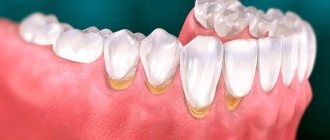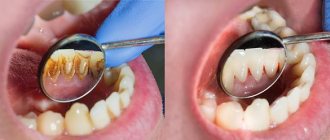Reasons for appearance
In medicine, a hole in the gum is called a fistula. A fistula appears as a consequence of the activity of harmful microorganisms that are located in the area of the alveolar process. As a rule, the causative agents of pathology are coccus bacteria.
That is, the main reason for the formation of a fistula is a large amount of pathogenic microflora in the mouth. Lack of hygiene, the accumulation of soft plaque and the formation of tartar provoke the appearance of a fistula in the gums. Over time, tartar grows and begins to put pressure on the gums. In addition, soft dental deposits spoil the aesthetics of a smile; pigment spots may appear on the enamel.
Another reason for the appearance of a fistula near a tooth may be infectious inflammation. Diseases such as tonsillitis, ARVI, and whooping cough reduce immunity, creating all the conditions for the proliferation of bacteria.
What can you do to speed up the healing process?
Only “sterile conditions” in the oral cavity will allow the wound to heal quickly, although this is a rather relative concept. There are both harmful and beneficial bacteria in the mouth. In addition, internal diseases can sometimes negatively affect the gum healing process:
- intestinal dysbiosis;
- pathological phenomena in the gastrointestinal tract, esophagus.
The main thing is to prevent the development of secondary infection of the hole, adhering to certain rules so that the wound heals and heals. So, you need to do the following:
- hold the gauze swab placed in the hole by the doctor more tightly in the first few hours after tooth extraction, squeezing with the jaws;
- stop smoking, drinking alcohol and hot solid foods for the first 2-3 days until the healing process and formation of new bone takes place;
- do not wash out blood clots, which create a kind of plug (protection) from the penetration of harmful bacteria and microorganisms;
- avoid accidental injury to the socket, i.e. it is better to chew food on the other, healthy side;
- stop playing sports, visiting saunas and overheating in the sun for 3-4 days;
- It is advisable not to sleep on the sore side of the jaw in the first days;
- rinse your mouth with herbal decoctions, although doctors do not recommend doing this to avoid washing out blood clots.
Often, out of ignorance and mistake, patients begin to vigorously rinse their mouths with various traumatic means at hand (soda, salt, hydrogen peroxide) so that the hole space heals faster, thereby aggravating the process and significantly delaying the healing time of the hole. All that happens is irritation, destruction and washing out of blood clots, and increased pain. All this may be a reason to return to the dentist and perform a secondary operation.
Of course, some adherents of traditional medicine try to minimize unpleasant symptoms using herbal infusions, decoctions and lotions. Dentists approve ointments and gels with anti-inflammatory and wound-healing effects so that the wound begins to heal faster.
The main thing is not to neglect the frequency and duration of home treatments. You can make gentle infusions and lightly rinse your mouth to remove food particles after each meal. Although in the first days it is extremely undesirable to do this. Such leaching can lead to the liquefaction of blood clots, a process of “gurgling” in the mouth.
You can use weak solutions of herbal decoctions (chamomile, sage) or Furacilin, Chlorhexidine, as pharmaceuticals. It is better to first consult a doctor and apply it carefully, without overdoing it, so that the healing of the hole occurs comfortably and gradually.
Fistula in the soft periodontal tissues after tooth extraction
The formation of a hole after tooth extraction is normal. As a rule, the hole heals within one to two weeks. If the operation was performed on wisdom teeth, the tightening process may take several weeks. Impaired socket tightening can occur due to infection or in case of injury to the area where the tooth was removed.
In a situation where the hole has tightened and a gap has formed in the periodontium, it may indicate that the tooth was not completely removed. Small fragments of the tooth gradually begin to decompose, forming a fistula.
Forms of alveolitis
Depending on the course of the complication, three stages are distinguished:
- Serous.
It makes itself felt
2-3 days
after tooth extraction. At this stage, pain occurs when eating, headache. Lymph nodes increase in size. - Purulent.
This is the next form that occurs after the serous one, if timely treatment is not carried out. Diagnosed a week after the tooth was removed. The pain becomes unbearable and is also felt in the head or ear. The hole becomes covered with a purulent, dirty yellow coating. There is an unpleasant odor from the mouth. Swelling and lymph nodes enlarge and become painful. Opening your mouth and eating food is extremely difficult due to pain. - Hypertrophic.
At this stage, it seems that the symptoms are subside: the condition is normalized, the temperature decreases. However, atrophied tissue grows, and when pressure is applied, pus is released from the inflamed wound.
If you notice any of the above symptoms, you should not self-medicate, but rather consult a dentist.
Fistula between tooth and gum
A hole between a tooth and periodontal tissue indicates the development of cervical caries or the complications it caused. Cervical caries can be located between the teeth and not be visible to the naked eye. Due to its inaccessible location, such caries often turns into pulpitis.
Pulpitis is an inflammation of the blood vessels and nerve endings located in the pulp chamber of the tooth. The chronic stage of the pathology may be accompanied by the formation of a purulent focus in the soft tissues. If pulpitis progresses to the next stage of periodontitis, several fistulas may appear at once.
Complicating factors
The extraction procedure itself is ordinary and highly predictable, given the level of modern dentistry and the technological equipment of clinics. Nevertheless, even such manipulation has complications, especially if you take it lightly. It is worth taking into account that each clinical case is individual: if in one case tooth extraction is not very difficult, then in another the dental surgeon has to apply all his skills and use advanced technologies and equipment in treatment. It is no coincidence that the price lists of clinics include the item “Complicated tooth extraction”: you have to pay more for this service. Experts identify several factors that can lead to complications, including fragments in the socket.
- Wisdom teeth.
Because of their remoteness, default eights are quite difficult to remove. They often grow incorrectly or do not fully erupt, which increases the risk of complications during removal. - Retention.
A tooth that has not fully erupted, when only part of the crown is visible above the gum or is completely hidden in the soft tissues. - Dystopia.
The tooth erupts at the wrong degree and abuts its neighbors. - The tooth is severely damaged due to trauma.
In such a situation, when removed, it may crumble, and some of the fragments will remain in the hole.
The appearance of a hole in the periodontium in a child
The formation of a hole in the gum near a tooth in a child can be due to reasons such as: periodontitis caused by complicated caries, or injury to the oral mucosa. With periodontitis, the lesion reaches the jaw bone. A cavity appears inside the periosteum, which is filled with pus. When there is an excess of pus, it breaks out through the fistulous tract, thereby bringing severe pain.
Frequent mechanical damage to the mucous membrane and gums causes infection to enter the oral cavity. Bacteria entering the periodontium cause inflammation and fistula formation.
Causes of dry socket
There are several causes of dry socket. Some of them can be prevented by following simple recommendations regarding personal hygiene and caution. Causes:
- smoking. In this case, there is a decrease in pressure in the oral cavity, which can lead to the loss of the formed clot;
- neglect of oral hygiene;
- low blood clotting;
- taking oral contraceptives;
- mechanical damage to the hole itself or the tissues around it.
In addition to the above reasons, a dry socket can appear as a result of an incorrectly performed tooth extraction procedure. During a complex extraction, when the tooth had to be removed from the gums in parts. All rules recommended before and after extraction must be followed.
Symptoms
Signs of fistula formation include:
- aching pain that increases in the evening;
- burning and itching of gums;
- swelling in the affected area;
- gum hyperemia;
- increased body temperature;
- general weakness, chills;
- increased irritability;
- apathy.
The appearance of symptoms of pathology is individual for everyone. Some may experience very severe pain and discomfort in the mouth, while for others the symptoms may be almost invisible.
How is tooth extraction performed?
It all starts with a consultation. The doctor will take a three-dimensional photograph, assess the location of the tooth in the jaw, the number and direction of the roots - wisdom teeth are famous for their unusual anatomy. All other human teeth are classified and have their own standard structure options, while the shape of wisdom teeth is random.
By the way, why wisdom? The point is the timing of the formation of tooth germs. All other teeth are formed in utero and after birth only continue their development and eruption. The formation of figure eights in the jaws occurs at the age of 4-5 years, and the beginning of teething occurs at an older age, hence the connection with wisdom.
After assessing the situation based on the image, you will be scheduled for surgery. At the appointment, the doctor administers anesthesia and removes the tooth. Most often, you need to make a small incision in the gum and cut the tooth into several parts; you can read more in detail here.
After removal, the additional incision is sutured, but the hole itself remains. The doctor inserts a membrane made from the patient’s venous blood into it - before the operation begins, the blood is taken and the tube is sent to a centrifuge, where the membrane is formed. Experience has shown that this will heal better and faster. A blood clot forms in the hole with the membrane, through which it will heal.
Treatment
If you find a fistula on the gum, you should immediately go to see a dentist. Based on the diagnosis and identification of the causes of the disease, appropriate treatment is prescribed.
Treatment can be carried out in two ways:
- drug treatment;
- surgical treatment.
If the cause of the formation of a fistula is a carious process or pulpitis, then the following treatment is carried out:
- destroyed dentin is removed;
- The cavity is processed and a filling is applied.
Then, to eliminate inflammation and remove pus, the following is prescribed:
- rinsing with antiseptics;
- antiseptic and analgesic gels and ointments;
- Antibiotics may be prescribed if necessary.
If the cause of the hole is periodontitis or an infection that has penetrated into the root of the tooth, surgical intervention is performed.
In the first case, the fistula is opened, the accumulated pus is removed through drainage, and the cleaned hole is treated with antiseptics and covered with a medicinal bandage.
When an infection occurs, not only the gums are opened, but also the alveolar process. After treatment of the tooth root, bone augmentation is performed. If the root is severely damaged and cannot be treated, the tooth must be removed.
What to do if the tooth is not completely removed?
If a piece of a tooth or part of a root remains after removal, and the doctor did not notice it, then sooner or later the symptoms described above will appear. What to do if a tooth is pulled out and a fragment remains? First of all, there is no need to panic. A regular x-ray can detect the presence of foreign bodies, including remaining fragments. In most cases, tooth removal does not take much time and is performed using standard surgical techniques. If the case is complex, an incision of the mucosa may be required. Today there are advanced surgical treatment techniques, such as laser surgery. Thanks to this, in difficult cases it is possible to reduce the invasiveness of the intervention. Be that as it may, for a qualified dentist, coping with the complication will not pose any great difficulties. The main thing is to contact him in time.
Many people are interested in whether the tooth root can come out on its own. If after removal part of the root remains in the gum, then you definitely shouldn’t count on it. Sometimes a tooth fragment may come out on its own, but there is no need to hope for this either. Moreover, you should not try to remove a tooth fragment from the socket yourself. You will most likely hurt yourself even more. If you notice remains of a tooth in the hole, go to the doctor immediately.
Prognosis and possible complications
If the fistula is detected and treated in a timely manner, the prognosis is favorable. If you follow all the specialist’s recommendations, within a week the resulting wound will completely heal and heal.
If proper treatment is not carried out, the following consequences are possible:
- abscess formation;
- phlegmon;
- osteomyelitis;
- tooth loss.
Preventive measures
- regular teeth cleaning;
- carrying out professional hygiene in the dental office;
- preventive examinations by a dentist every six months;
- daily consumption of fruits and vegetables.
Why does the hole take a long time to heal?
Epithelization of the gums after the operation begins after a couple of days, and a white coating appears on it. Now it doesn’t hurt so much anymore, and there are no signs of inflammation. At this time, it is better not to touch the mucous membrane, but just continue to properly take care of the hole. It may not heal for a long time due to the patient’s personal quirks, at a time when there are diseases of the circulatory system or chronic inflammatory processes in the body.
If your gums hurt very badly after seven days, this is possible:
- Dry socket or alveolitis - this complication often appears when the rules for organ removal are not followed, while part of the crown or root remains in the socket. Under such conditions, the blood clot, which should protect against infection, falls out. This complication much more often begins on the 5th day after the end of the operation. Common symptoms are gum discoloration, unpleasant odor, halitosis, soreness, slight bleeding;
- Chronic bleeding - this complication is observed in people with hypertension and in the case of blood diseases. This may result in alveolitis. Before sending the patient home, the dentist stops the bleeding and places a hemostatic sponge on the hole;
- A fracture or dislocation of the lower jaw is a rare complication that occurs more often during the removal of a wisdom tooth; the risk increases if there is a cystic formation or acute inflammatory process in the root area;
- Perforation of the maxillary sinus is possible as a result of complex removal of chewing teeth in the upper jaw.
If the hole hurts for a long time, and it does not go away after seven days, you should immediately consult a doctor. It is forbidden to cope with complications that appeared during the removal on your own. Apart from this, there is no way to prevent them, so first aid is provided immediately after the procedure is completed.
Complications due to improper care, which slow down gum healing, can be prevented on your own.
Symptoms of alveolitis of the socket
Alveolitis goes through several stages of development, each of which has its own clinical picture:
| Stage | Description |
| Serous inflammation | The first clinical symptoms appear the next day or after 3 - 4 days after surgery. Non-purulent inflammation is manifested by the appearance of episodic pain and swelling of the soft tissues around the alveoli. |
| Purulent alveolitis | If measures were not taken at the previous stage, a purulent process develops within a few days. The pain becomes constant, radiating to the auricle, jaw, and neighboring teeth. The infection spreads to nearby lymph nodes, causing them to enlarge. A gray-green coating appears inside the hole. The temperature rises. |
| Purulent-necrotic stage | The pain intensifies and becomes throbbing. A putrid odor appears from the mouth. Progression leads to disruption of microcirculation, ischemia, and the development of necrosis. The patient’s health deteriorates significantly, and signs of intoxication appear. |
| Hypertrophic tissue change | Lack of medical intervention within 14 days leads to chronicity of the process. Soreness and swelling become less pronounced. Soft tissues grow and fill the hole. When pressure is applied to the granulation, pus is released. The mucous membrane is swollen, bluish in color. |
If left untreated, alveolitis has an unfavorable outcome. The main complications after alveolitis:
- phlegmon (extensive purulent inflammation);
- acute periostitis (inflammatory process of the periosteum);
- osteomyelitis (purulent-necrotic inflammation of the jaw bone);
- sepsis (purulent-septic blood disease).
Do not rinse your mouth for the first 24 hours.
It is necessary to avoid warm foods and drinks, and not to take alcohol or blood thinners. It is possible to numb the wound with drugs such as Nimesil, Ibuprofen, Paracetamol. While brushing your teeth, you must avoid moving the bristles near the removed organ. If bleeding starts unexpectedly after a couple of days, you should immediately go to the doctor. This also applies to those cases when the pain is not relieved by simple analgesic and anti-inflammatory drugs.
On the third day, it is already possible to start rinsing the oral cavity with warm antiseptic solutions and herbal decoctions. This will speed up the healing of the hole and prevent inflammation and infection of the wound. For a couple more days you need to refrain from heat, sports, saunas, baths.
Some medications can have the opposite effect, leading to bleeding, so the medication must be coordinated with the dentist. Before removing the doctor, it is imperative to give a warning about concomitant and previous diseases. Tooth extraction has contraindications, and if they are missed, complications cannot be avoided.










